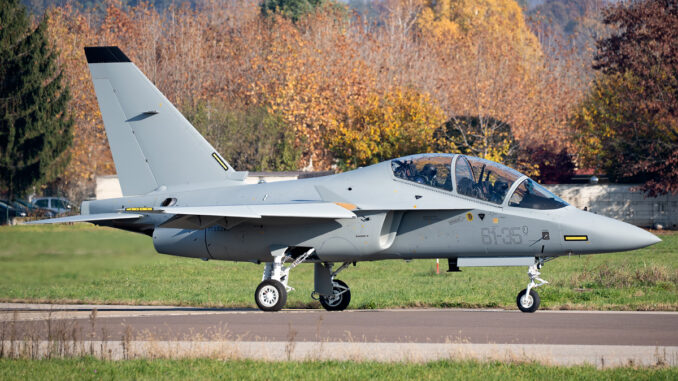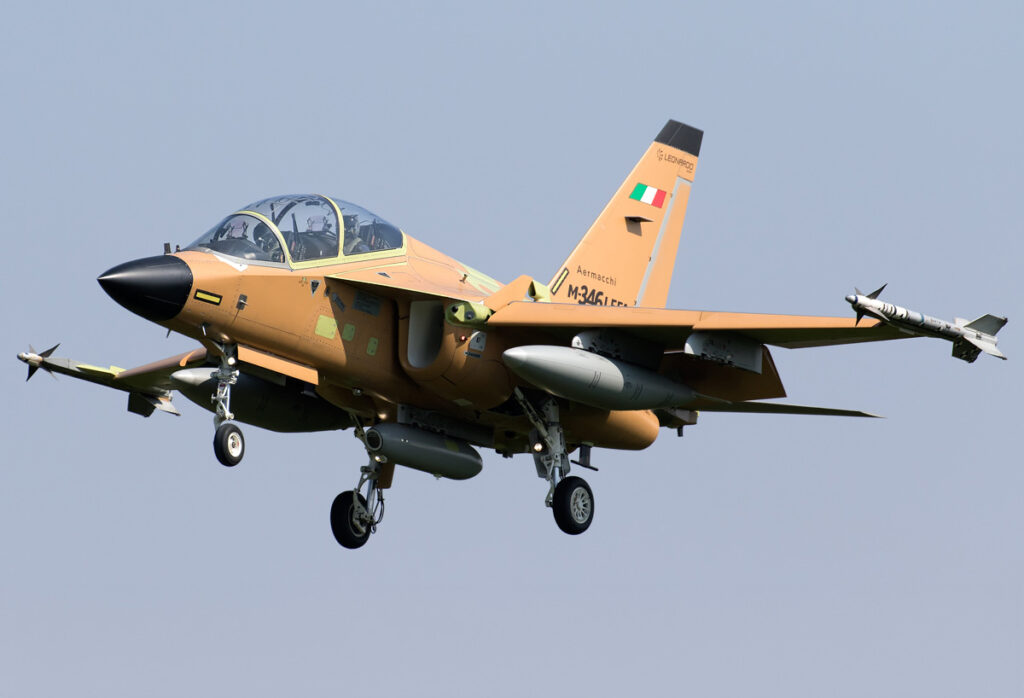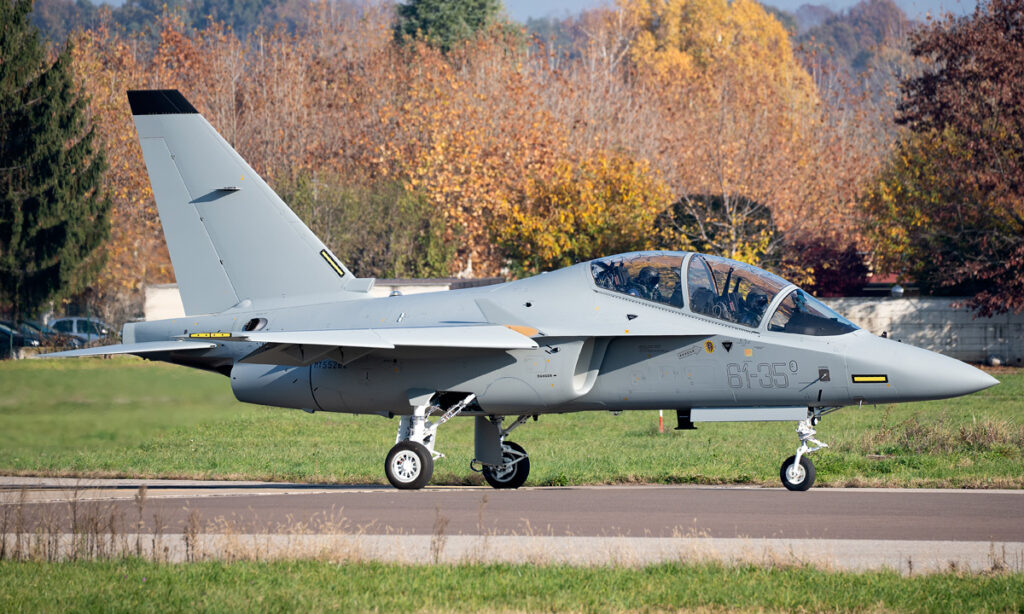
Austria is studying the joint acquisition of M-346s with Italy to replace its Saab 105s, with training and air defence capabilities.
Austria is exploring the possibility of a joint acquisition with Italy of Leonardo M-346 training aircraft to replace the Saab 105s being withdrawn in 2020. This initiative aims to enhance pilot training capabilities while offering surveillance and air defence functions. The Austrian Ministry of Defence, under the direction of Klaudia Tanner, has launched a legal review to assess this option and, in the absence of obstacles, plans to enter into formal discussions with Italy. This project is part of a series of joint purchases aimed at modernising the Austrian air force.

The need to replace the Saab 105: a strategic opportunity for Austria
Austria retired its Saab 105s in 2020, leaving a gap in its military pilot training and air defence capabilities. Since then, the search for a suitable replacement has become a priority for Vienna. The Saab 105, which was used exclusively for pilot training, no longer met modern technological and strategic requirements. In response to this need, Austria is now considering the acquisition of the Leonardo M-346, a multi-purpose aircraft capable not only of training pilots, but also of carrying out surveillance and air defence missions.
The Leonardo M-346 is an advanced training aircraft developed by Italy, designed to simulate the performance of fourth- and fifth-generation fighters. With a maximum speed of 1,059 km/h and an operational range of around 2,590 km, the M-346 offers performance that far exceeds that of the Saab 105. What’s more, the M-346 can be fitted with weapons systems, transforming it into a light fighter capable of air defence missions. This versatility is essential for Austria, which is seeking to maximise the efficiency of its air fleet while meeting a variety of security requirements.
A strategic partnership with Italy: towards a joint acquisition
Austria’s decision to consider a joint purchase with Italy for the M-346 is part of a wider strategy of international defence cooperation. This approach will not only enable acquisition and maintenance costs to be shared, but will also strengthen military ties between the two countries. The Austrian Defence Minister, Klaudia Tanner, has launched a legal review to assess the feasibility of this partnership and has expressed a desire to move ahead quickly with the process.
This project follows a growing trend in Austria to engage in joint procurement of military equipment. For example, at the Farnborough Airshow, Austria signed an agreement with the Netherlands for the joint procurement of four Embraer C-390 transport aircraft. This collaboration with the Netherlands reflects Austria’s desire to modernise its armed forces while benefiting from the economic and operational advantages of joint procurement.
In addition, Austria already has positive experience of cooperation with Italy, notably with the purchase of the Leonardo AW169M helicopter. This precedent shows that Austria and Italy have the capacity to carry out joint procurement projects, which reinforces the likelihood that the purchase of the M-346s will be a success.
Austria’s alternatives: a tight competition
Although the M-346 is a serious candidate, Austria is also evaluating other options to replace its Saab 105s. These include the Boeing T-7, a trainer developed by Boeing in collaboration with Saab, and the L-39N from Czech manufacturer Aero Vodochody. Each of these aircraft has unique features that meet Austria’s specific training and defence requirements.
The Boeing T-7, for example, is an advanced trainer aircraft designed to train fifth-generation fighter pilots. With a maximum speed of 1,300 km/h and a high payload capacity, the T-7 is well suited to simulating the performance of modern fighters. Its modular design and simplified maintenance system also make it attractive to air forces looking to reduce life-cycle costs.
The L-39N, meanwhile, is a modernised version of the famous L-39 Albatros, a trainer used by many air forces around the world. The L-39N is equipped with modern avionics and can be configured for surveillance and light defence missions, making it a versatile option for Austria.
However, despite these alternatives, the M-346 remains a top choice due to its versatility, compatibility with modern weapon systems and Austria’s positive experience of working with Leonardo on other projects.
The benefits of acquiring the M-346 for Austria
The acquisition of the M-346 would offer Austria several strategic advantages. Firstly, the aircraft would modernise the training capabilities of Austrian pilots, providing them with a realistic and up-to-date training environment. In addition, the M-346, with its light combat capabilities, could strengthen the country’s air defence, a crucial consideration in an increasingly complex European security context.
In economic terms, a joint acquisition with Italy would enable Austria to benefit from economies of scale, reducing the unit cost of the aircraft and maintenance costs. This is part of Austria’s wider strategy to maximise budgetary efficiency while strengthening its military capabilities.
In addition, the integration of the M-346 into the Austrian air fleet would enhance interoperability with the Italian air force, facilitating coordination during joint exercises and military operations. This increased cooperation could also serve as a model for future collaboration with other European countries, strengthening collective security in the region.

A crucial decision for the future of Austrian defence
Austria’s exploration of a joint acquisition of the M-346 with Italy represents a major opportunity to modernise its air forces and strengthen its defence capabilities. By choosing the M-346, Austria could not only effectively replace its Saab 105s, but also acquire a versatile aircraft capable of meeting a variety of operational requirements.
This decision, which is part of a series of joint military purchases, demonstrates Austria’s willingness to engage in strategic partnerships to strengthen its national defence while optimising its resources. As the legal assessment continues, it is clear that the acquisition of the M-346 could have a significant impact on the security and effectiveness of the Austrian armed forces in the years to come.
War Wings Daily is an independant magazine.